Nuance ScanSoft OmniForm User’s Manual

OmniForm Reference
Version 2 for Windows 95/NT/3.1
CAERE CORPORATION
100 Cooper Court
Los Gatos, California 95030
European Offices:
Caere GmbH
Innere Wiener Strasse 5
81667 Munich
Germany
Please Note
In order to use this program, you should know how to work in the Microsoft Windows environment. Please refer to your Windows documentation if you have questions about how to use menu commands, dialog boxes, scroll bars, edit boxes, and so on.
OmniForm Reference
Version 2 for Windows 95/NT/3.1
Copyright© 1996 Caere Corporation. All rights reserved. CAERE®, Logical Form Recognition, and OmniForm are trademarks of Caere Corporation.
Formonix is a trademark of Formonix, Inc.
Many of the designations used by manufacturers and sellers to distinguish their products are claimed as trademarks. Such designations appearing in this manual have been printed in initial caps.
Product Serial Number:
_______________________________________________
(from Disk #1 label)
2

Chapter 1
Introduction
OmniForm is the easy way to convert your paper forms to electronic forms. Use OmniForm to edit, design, and fill forms, manage information databases, and print, fax, and mail forms among other functions.
This chapter gives an overview of the form creation and information management capabilities OmniForm provides, as well as an explanation of how to use the documentation.
This chapter contains the following sections:
•OmniForm Features
•Using the Documentation
Introduction - 3

OmniForm Features
OmniForm Features
OmniForm, an easy-to-use environment for working with forms, is more than just form-recognition software. OmniForm includes the following features:
Form Input
OmniForm uses Logical Form Recognition™ to convert your scanned paper forms or imported image files into electronic, editable forms.
Fill View
Use OmniForm’s fill view to fill a form with the information you need.
Information entered can easily be searched and sorted.
Design View
Use OmniForm’s design view to design your own forms or edit existing forms. A variety of toolbars make formatting easy and convenient. Use the scrapbook to store or copy form objects.
OmniForm Database
All information you enter into a form is stored as a part of an OmniForm database. You can create, duplicate, sort, and search records, and import and export database information.
Field Validation
You can set up OmniForm to validate a fillable field automatically.
OmniForm displays a prompt if you enter incorrect information.
Field Calculations
OmniForm’s built-in operators and functions let you define calculations that display the correct value as you fill the appropriate field(s) in a form. This automates data entry and reduces the possibility of errors.
Form Printing, Faxing, and Mailing
You can print or fax forms from OmniForm. You have a choice of printing or faxing just the form, or just the data entered in a form, or both the form and its information.
Use electronic mail to send forms to other users if you have Microsoft
Exchange/Mail or Lotus cc:Mail/Notes installed. Microsoft Exchange/
Mail users can also add routing slips to mailed forms.
Introduction - 4

Using the Documentation
Using the Documentation
This section explains the various instructional and formatting conventions used in this manual.
Screenshots and Instructions
Most screenshots in this manual were taken in Windows 95. Your dialog boxes and windows may look slightly different if you are using Windows NT or Windows 3.1. For example, dialog box titles in Windows 95 appear in the top left of the box. Dialog box titles in Windows NT and Windows 3.1 appear in the top middle of the box.
Both screenshot versions are displayed when they differ significantly.
Instructions appropriate to each version of Windows are given where necessary — for example, double-clicking an icon in a program group (Windows 3.1 and NT) versus using the Taskbar (Windows 95). Any instruction specific to Windows NT and 3.1 appears immediately after the Windows 95 instruction.
Online Help
OmniForm has both online help and context-sensitive help. Use the commands in the Help menu to find information on OmniForm topics and on using Help itself.
Click the Help button in the OmniForm standard toolbar to turn your cursor into a question mark icon. Click any command, button, or portion of the window to open context-sensitive help for that topic.
Formatting
Two formatting conventions are used throughout the manual.
Italicized Text
•Labeled buttons, menu commands, dialog box text, and any text in an onscreen form are italicized; for example, “Choose Open in the File menu.”
Menu titles, icon names, dialog box names, and unlabeled buttons are not italicized.
•A new term may be italicized the first time it is used; for example, “This is a fill text field.” These terms and others are defined in the Glossary section of the manual.
•Variable entries are italicized; for example, “The entry n must be between 4 and 18.”
Introduction - 5
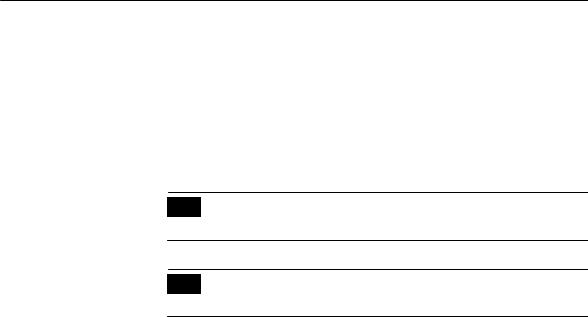
Using the Documentation
Courier font
•The Courier font indicates text that you are supposed to enter; for example, “Type Sample1 in the File Name text box and click OK.”
•The Courier font is also used to distinguish file paths and file and folder names from the rest of the text; for example, “Locate the Sample form in the OmniForm folder.”
Symbols
Two symbols are used in this manual to highlight text.
This symbol means Note. It introduces a tip or an item of note.
This symbol means Warning. It introduces cautionary text.
Introduction - 6

Chapter 2
Installation and Setup
This chapter describes how to install OmniForm and begin using it. It contains the following sections:
•Registering OmniForm
•System Requirements
•Installing OmniForm
•Starting OmniForm
Installation and Setup - 7

System Requirements
System Requirements
To install and run OmniForm, you need the following setup:
•Computer with an 80386 or higher processor.
•VGA or SVGA monitor.
•Windows-compatible mouse.
•1.44MB high-density floppy disk drive and internal hard disk.
•A minimum of 11MB hard disk space for the US version; 15MB for the International English version.
•If you plan to scan forms, you need a Hewlett-Packard (ScanJet Plus or above), Visioneer, or TWAIN-compatible scanner.
•Total system memory of at least 8MB RAM for Windows 95 and Windows 3.1; 12MB for Windows NT.
•At least a 4MB permanent swap file for Windows 3.1.
•MS-DOS 5.0 or above for Windows 3.1.
OmniForm 2.01 for Windows 95 and Windows NT will not run on earlier versions of Windows.
Registering OmniForm
Registering your copy of OmniForm entitles you to technical support, notification of special offers and upgrades, and the lowest price offered on the next OmniForm upgrade.
Please complete and send in the registration card included in your
OmniForm package.
See “Caere Product Support” on page 271 for information on technical support.
Installation and Setup - 8

Installing OmniForm
Installing OmniForm
This section describes how to install OmniForm on Windows 95, and on
Windows NT and 3.1.
OmniForm automatically decides which version of the program to install. If you are running Windows 3.1, for example, OmniForm installs the 16-bit Windows 3.1 version of OmniForm.
Close all applications — including screen savers and mail applications
— to free up memory before installing OmniForm.
Installing on a Windows 95 System
1Start Windows 95.
2Click Start in the Taskbar and choose Settings Control Panel. The Control Panel appears.
3Double-click Add/Remove Programs.
The Add/Remove Programs Properties dialog box appears.
4Click Install... in the Install/Uninstall tab.
5Insert OmniForm disk #1 in your computer’s floppy drive and follow the instruction in the dialog boxes.
Windows fills the Command line for installation program text box automatically and the InstallShield Wizard appears to guide you through the setup process.
6Follow the instructions in each dialog box that appears, and insert other installation disks as prompted. (Installation may not require all the disks provided.)
OmniForm installs by default to the location c:\Program Files. You can select another location if you wish.
Installation and Setup - 9

Installing OmniForm
Installing on a Windows NT or 3.1 System
1Start Windows NT or 3.1 and open the Program Manager window.
2Insert OmniForm disk #1 in drive a: (or b:) of your computer.
3Choose Run in the Program Manager File menu. The Run dialog box appears.
4Type a:\setup (or b:\setup) in the Command Line text box and click OK.
The InstallShield Wizard appears to guide you through the setup process.
5Follow the instructions in each dialog box that appears. OmniForm creates a Caere Applications folder if necessary. You can select another folder in the Select Program Folder dialog box if you wish.
6Insert other installation disks as prompted. (Installation may not require all the disks provided.)
An OmniForm icon is added to the Caere Applications program group when installation is complete.
Installation and Setup - 10
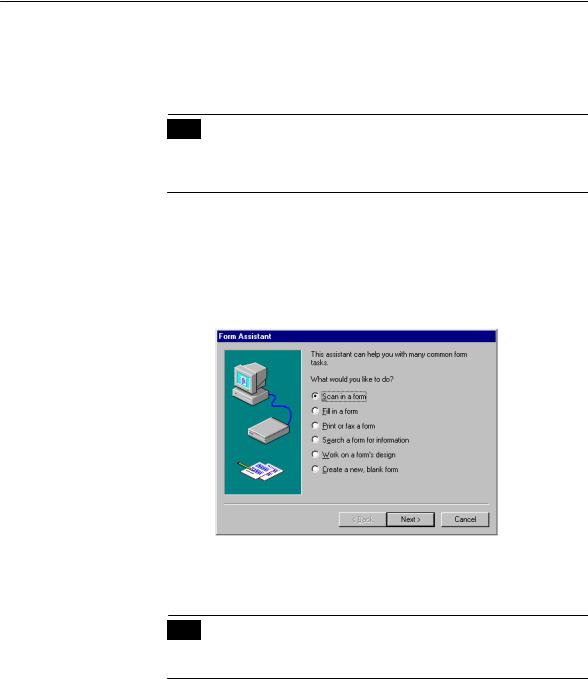
Starting OmniForm
Starting OmniForm
This section describes how to launch OmniForm after it is installed. Any instruction for Windows NT and 3.1, when different from that for Windows 95, appears immediately after the Windows 95 instruction.
Install your scanner and test it in Windows before using it with OmniForm. Consult your scanner documentation or the scanner manufacturer to resolve any scanner problems that occur.
To start OmniForm:
1Click Start in the Taskbar and choose Programs OmniForm. Windows NT and 3.1 users: double-click the OmniForm icon in the Caere Applications folder.
Form Assistant appears. It contains six options. Each is a basic OmniForm procedure.
2Select an option and click Next>.
Click Cancel to close Form Assistant if you do not want to choose a particular option.
See Chapter 5, OmniForm Procedures, for detailed information on the basic OmniForm procedures.
Installation and Setup - 11

Chapter 3
Tutorials
These tutorials guide you through some of the main features of OmniForm. There are four sections in this chapter:
•Tutorial 1 — Load and Fill a Form
•Tutorial 2 — Edit and Design a Form
•Tutorial 3 — Design Your Own Form
•Tutorial 4 — The OmniForm Database
Perform these exercises in order if you are new to OmniForm. Each new exercise builds upon skills learned in the previous one. Choose the tutorial you want to practice if you already know the basics of scanning, designing, and using forms.
The tutorials cross-reference sections in this manual for additional information on each subject. Read the other chapters in the manual to learn about OmniForm features not discussed here.
Most screenshots in this chapter were taken in Windows 95. Your dialog boxes and windows may look slightly different if you are using Windows NT or Windows 3.1.
Tutorials - 12
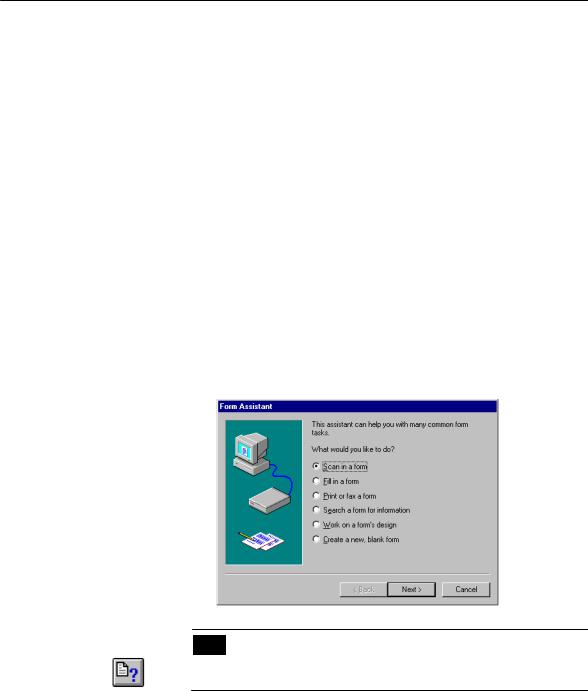
Tutorial 1 — Load and Fill a Form
Tutorial 1 — Load and Fill a Form
You will load the Sample form in this exercise in one of three ways:
•Scan in the Sample form with a scanner if you have one. The form is supplied inside this manual.
•Fax the Sample form to your computer’s fax modem if you have no scanner, use your fax software to save it as a PCX or TIFF file, and open it in OmniForm. The form is inside this manual.
•Locate and open the Sample.tif file if you have no scanner and no fax modem. It was placed in your OmniForm\Sample Forms folder during installation.
Decide which method you want to use. You can try all three methods eventually if you own both a scanner and a fax modem.
After you have loaded the form into OmniForm, you will practice various features of the program.
Launch OmniForm
Click Start in the taskbar and choose Programs OmniForm.
Windows NT and 3.1 users: double-click the OmniForm icon in the Caere Applications folder.
The Form Assistant dialog box appears.
If you accidentally close the Form Assistant dialog box, click the
Form Assistant button in the standard toolbar to reopen it.
Tutorials - 13

Tutorial 1 — Load and Fill a Form
•See the next section if you have a scanner and want to scan the form.
•See “Fax the Sample Form” on page 17 if you have a fax machine and a fax modem and want to fax the form to your computer.
•See “Import an Image File” on page 17 if you do not have a scanner or a fax modem, or if you want to use this method instead of the other two methods.
Scan the Sample Form
1Select Scan in a form and then click Next>.
2Select a source for the form in the next window.
•Select Hewlett-Packard Scanner if you have an HP scanner and proceed to step 5.
•Select TWAIN (all other scanners) if you have a TWAINcompatible scanner that is not an HP scanner.
3Click Next>.
4Users who selected TWAIN as the source can click Select Source... in the next window to select a TWAIN source.
•Select a source in the Select Source dialog box.
•Click Select to return to Form Assistant.
•Proceed to step 8 on page 15.
5Click Next> to continue.
Tutorials - 14
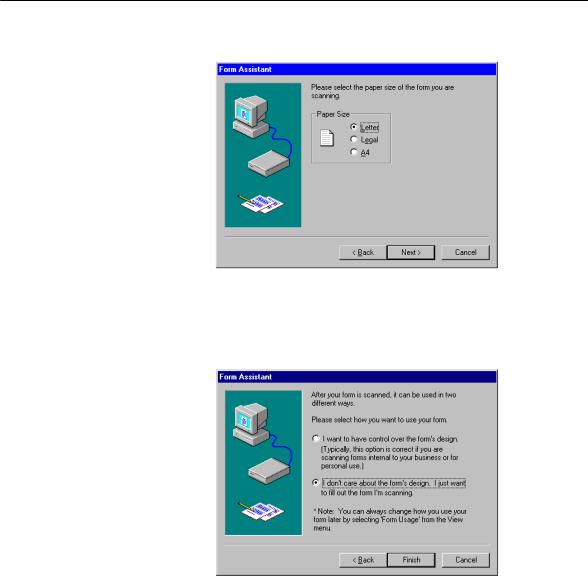
Tutorial 1 — Load and Fill a Form
6Select Letter in the next window if this option is not selected already.
The Sample form is a letter-sized page.
7Click Next>.
The next window offers two form usage options.
8Select the second option.
You will just fill the form in this exercise, not work on its design.
9Click Next>.
The next window prompts you to place a page in your scanner.
10Make sure the page is aligned correctly in your scanner, and click Finish.
Tutorials - 15

Tutorial 1 — Load and Fill a Form
OmniForm scans the form. The OmniForm window displays scanning, designing, and straightening progress.
The Sample form opens as Form1 in fill view. It should look the same as the original copy of the form.
11Click the Save button or choose Save in the File menu. The Save As dialog box appears.
12Type Sample1 in the File name text box and click Save.
Proceed to the section “Filling in the Form” on page 21 to begin using OmniForm’s tools.
Tutorials - 16

Tutorial 1 — Load and Fill a Form
Fax the Sample Form
To fax the Sample form, you need the following:
•a fax modem connected to your computer
•fax software that is compatible with your fax modem
•access to a regular fax machine
To fax the form:
1Make sure your fax modem is turned on and that your fax software is set up to receive a call.
Refer to your fax manual(s) for information.
2Place the Sample form in the fax machine.
3Set faxing resolution to Fine or Best.
This setting faxes the form at a resolution of 200 x 200 dots per inch (dpi). OmniForm may have trouble recognizing documents faxed at a lower resolution. (Standard resolution is 200 x 100 dpi.) Check your fax machine’s manual if you need more information about its settings.
4Dial your fax modem’s number and fax the Sample form as you normally would.
5Once received, use your fax software to open the Sample form and save it as a PCX or TIFF file.
Again, refer to your fax software manual if you do not know how to do this.
6See the next section, “Import an Image File” for instructions on how to convert your fax file into an electronic form in OmniForm.
Import an Image File
OmniForm can recognize PCX or TIFF image files. An image is an electronic picture of text and/or graphics. This could be a form created in another program or one received as a fax file. See the previous section, “Fax the Sample Form” if you want to create a fax file to import.
You will import an image file in this exercise. You can import a fax file if you have one, or import the Sample.tif form that was placed in your OmniForm/Sample Forms folder during installation.
Tutorials - 17
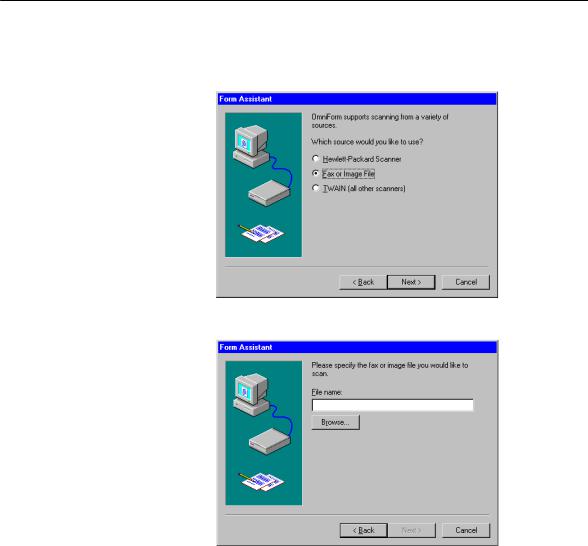
Tutorial 1 — Load and Fill a Form
Load the Image File in OmniForm
1Select Scan in a form in Form Assistant and then click Next>.
2Select Fax or Image in the next window and then click Next>.
3 Click Browse... in the next window.
The Browse dialog box appears.
Tutorials - 18
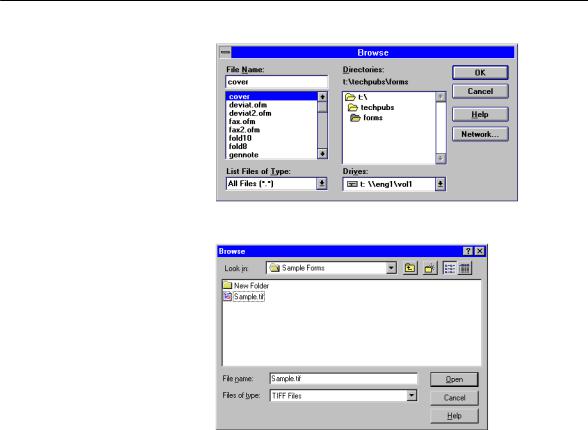
Tutorial 1 — Load and Fill a Form
4 This is how the dialog box looks in Windows 3.1 and NT.
5 This is how the dialog box looks in Windows 95.
•Select TIFF Files in the Files of type drop-down list if you want to import the Sample.tif file. Locate and select the Sample file in the OmniForm\Sample Forms (omniform\samples in Windows 3.1) folder.
•Locate and select your fax file if you created one in the previous exercise.
•Click Open to return to Form Assistant.
The file name appears in the File name text box.
6Click Next>.
The next window offers two form usage options.
Tutorials - 19
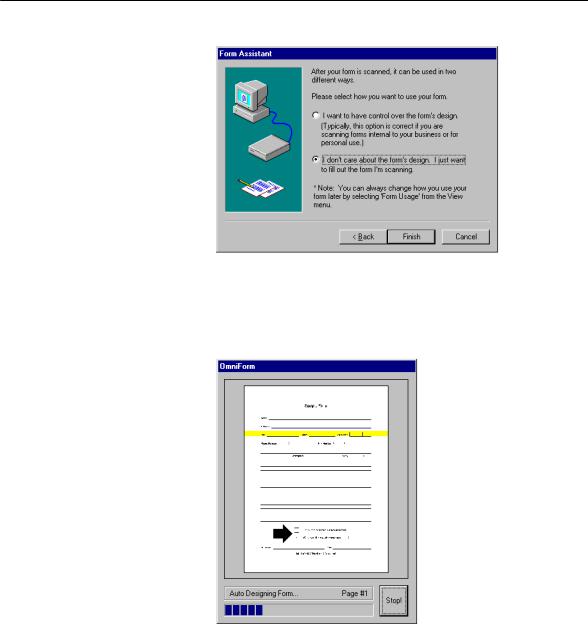
Tutorial 1 — Load and Fill a Form
7 Select the second option.
You will just fill the form in this exercise, not work on its design.
8Click Finish>.
The OmniForm window displays scanning, designing, and straightening progress.
The Sample form opens as Form1 in fill view.
Tutorials - 20
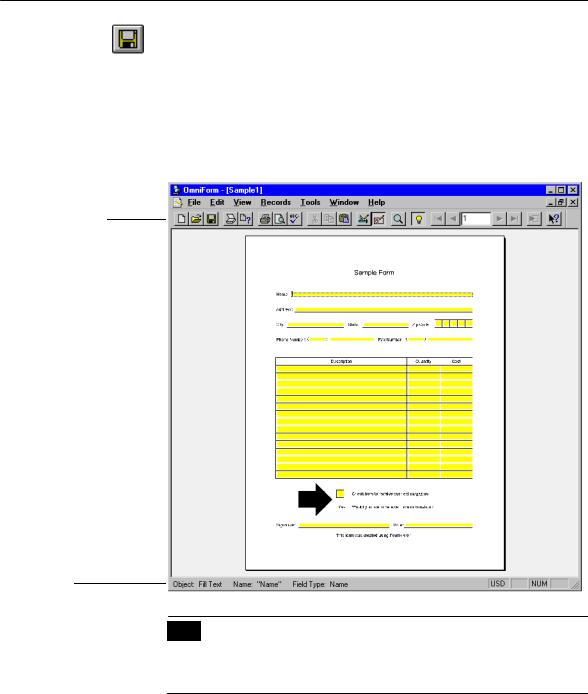
Tutorial 1 — Load and Fill a Form
9Click the Save button or choose Save in the File menu. The Save As dialog box appears.
10Type Sample1 in the File Name text box and click Save.
The next section shows you how to begin using OmniForm’s tools.
Filling in the Form
The Sample form you scanned or imported in the previous exercise opens in fill view.
Standard toolbar in fill view
Status text
If you closed the form after the last exercise, click Cancel in Form Assistant if it opens when you next launch OmniForm. Choose Open...
in the File menu and locate the Sample1 file where you saved it.
Tutorials - 21
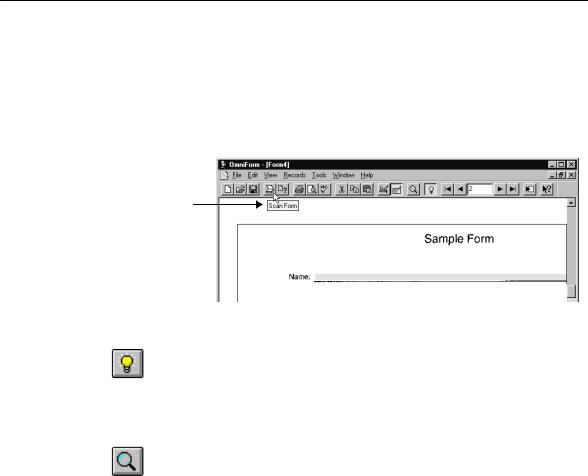
Tutorial 1 — Load and Fill a Form
Fill View Overview
The standard toolbar appears below the menus. The buttons correspond to various menu commands. See “Menu Commands” on page 110 for a description of all menu commands.
1Place your cursor over one of the buttons and hold it there without clicking.
A ToolTip describes the button’s function.
Hold the cursor over any button in the toolbar to see its function.
Corresponding status text simultaneously appears in the status bar at the bottom of the window.
2Click the Highlight button in the toolbar or choose Highlight Fill Areas in the View menu to turn off field highlighting.
OmniForm highlights all recognized fields in yellow. This makes it easy to see which fields you can fill.
3Click the button again to turn field highlighting back on.
4Click the Zoom button and select a page view in the dropdown list.
Alternatively, choose Zoom in the View menu and select a view in the cascading menu.
You have a choice of 50%, 75%, 100%, 150%, 200%, 300%, 400%, Page Width, or Whole Page views.
Fill in the Fields
1Click the field after Name on the form or press the Tab key to place the cursor there.
This is a fill text field. The word Name on the form is text.
2Type your name in the fill text field.
Tutorials - 22
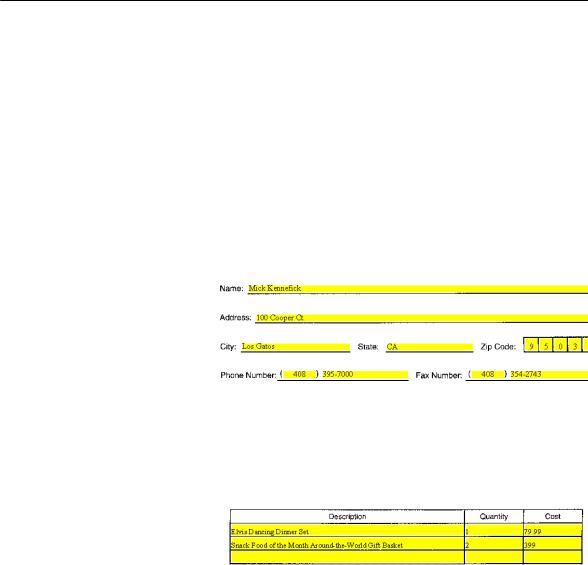
Tutorial 1 — Load and Fill a Form
3Continue to press the Tab key to move to and fill in the Address, City, and State fields (or click to place the cursor there).
You can press Shift-Tab to move to a previous field.
4Tab to or click in the Zip Code field.
This is a comb field. This is a field that is subdivided into comb elements. The next fields, Phone Number and Fax Number, are also comb fields.
5Type five numbers in the Zip Code field.
You do not have to click in each box in the field. OmniForm moves the cursor automatically for you.
6Tab to or click in the Phone Number comb field and type ten numbers.
The parentheses are already on the form, but you have to type a hyphen between numbers yourself.
7Fill in the Fax Number comb field.
The next item is a table. A table contains cells and each cell contains a field. The cells in the table are all fill text fields. The headers in the table are text and cannot be changed in fill view.
•Click in the field under Description and type Elvis Dancing Dinner Set.
•Press the Tab key to move to the field under Quantity and type
1.
•Press the Tab key to move to the field under Cost and type
79.99
•Fill in as many fields as you like.
Tutorials - 23
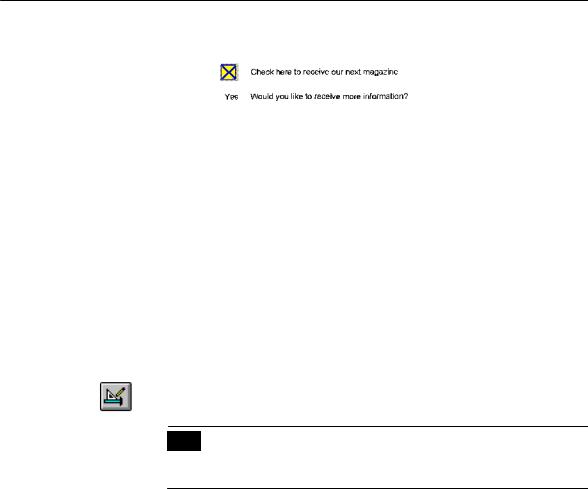
Tutorial 1 — Load and Fill a Form
8Move down the page and click in the square next to the words
Check here to receive our next magazine.
An “X” appears in the box. This is a check box field.
9Click the word Yes next to the words Would you like to receive more information?
Nothing happens. This should be a circle text field but there was no circle on the form to indicate this to OmniForm during form recognition.
OmniForm provides tools to compensate for missing information on forms. The next section describes how to create the circle text field, as well as other design and formatting techniques.
Design View
There are two views in OmniForm: fill view and design view. You fill in fields in fill view. In design view, you can create and format objects (these become fields in fill view) and add graphics to a form, among other functions.
Click the Design button in the standard toolbar or choose Design in the View menu.
As a handy shortcut, click the right mouse button to open a shortcut menu. Choose Design in this menu.
Tutorials - 24
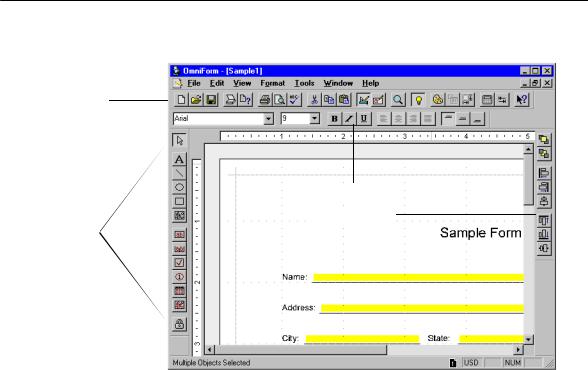
Tutorial 1 — Load and Fill a Form
OmniForm switches to design view. Any text you entered in fill view disappears in design view. It still exists in fill view.
Standard toolbar
Font/text toolbar
Arrange toolbar
Drawing toolbar 
There are four toolbars in design view: the standard toolbar (different in design view than in fill view), the font/text toolbar, the drawing toolbar, and the arrange toolbar.
•Use the standard toolbar for basic file operations such as saving and printing, and for working with objects.
•Use the font/text toolbar to format characters and paragraphs.
•Use the drawing toolbar to create objects: circles, tables, text, etc.
•Use the arrange toolbar to arrange and align objects on a form.
(Design view also contains the calculation toolbar which appears when you choose Calculation in the Tools menu. See Chapter 9, Using Calculations, for more information.)
Tutorials - 25
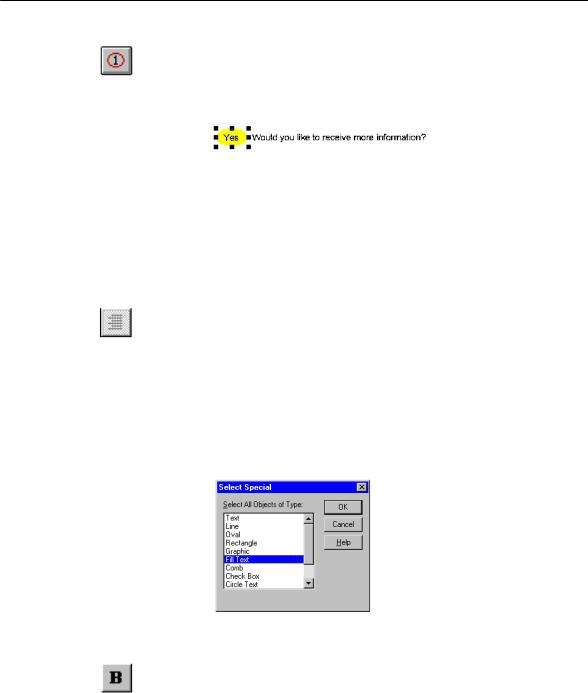
Tutorial 1 — Load and Fill a Form
Create a Circle Text field
1Click the Circle Text tool in the drawing toolbar. Your cursor changes to a plus sign with a circle.
2Draw a circle (or oval) around the word Yes next to the words
Would you like to receive more information?
You will select this circle later in fill view.
Format Text
1Click the table to select it.
2Click the first field under the word Cost in the table to select it. In an object with multiple elements — a comb or table — you must always click to select the whole object first and then click again to select the specific element.
3Click the Right Alignment button in the font/text toolbar. Hold your cursor over the button without clicking to see the ToolTip if you have trouble finding the button.
Now numbers entered in this Cost cell will be right-aligned. If you format the other cells under Cost all the decimal points will line up.
4Choose Select Special... in the Edit menu. The Select Special dialog box opens.
5Select Fill Text and click OK.
All fill text fields are selected, including the fill text fields in the table cells.
6Click the Bold button in the font/text toolbar. Now all text in the fill text fields will be bold.
Tutorials - 26

Tutorial 1 — Load and Fill a Form
Return to Fill View
1Click the Fill button in the standard toolbar to return to fill view.
The text in fill fields is now bold and the number in the table’s Cost cell is right-aligned.
2Click the word Yes next to the words Would you like to receive more information?
This time, a circle appears around the word Yes.
Print the Form
1Click the Save button or choose Save in the File menu.
2Choose Print... in the File menu. The Print dialog box appears.
3Select the print options you want.
4Click OK in the Print dialog box to print a copy of your form.
See “Using the Print... Command” on page 97 for detailed information on the Print dialog box.
Fax the Form
You must have fax hardware and software installed in order to fax a form. Refer to your fax documentation for instructions on how to set up your equipment for faxing. Faxing uses the Print command.
1Choose Print... in the File menu. The Print dialog box appears.
2Select the print options you want.
3Click OK in the Print dialog box to fax a copy of your form. Depending on your fax software, more dialog boxes may appear after you click OK in the Print dialog box.
See “Using the Print... Command” on page 97 for detailed information on the Print dialog box.
You will practice more advanced form editing and design in the next tutorial.
Tutorials - 27
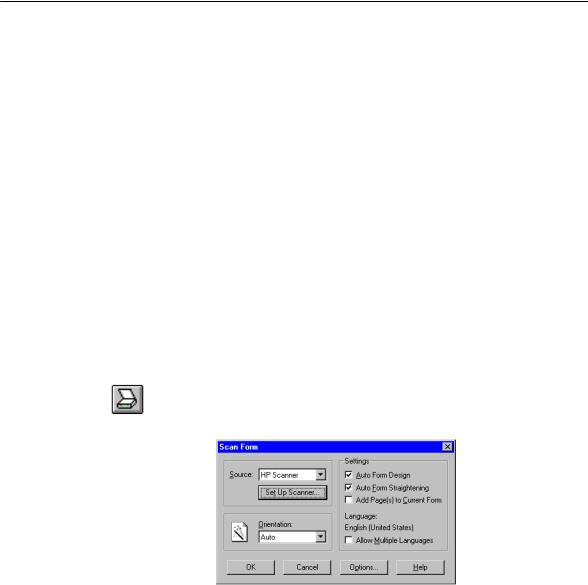
Tutorial 2 — Edit and Design a Form
Tutorial 2 — Edit and Design a Form
You will scan or import the Sample form into OmniForm again in this exercise. This time, you will bypass the Form Assistant dialog box so that you can see which buttons and menu commands to use. You will verify and correct OCR, and practice redesigning the form. See Chapter 6, Designing a Form, for detailed information on form design.
Launch OmniForm
If OmniForm is already open, proceed to the next section.
1Click Start in the taskbar and choose Programs OmniForm to launch OmniForm if it is not open already.
Windows NT and 3.1 users: double-click the OmniForm icon in the Caere Applications folder.
2Click Cancel in the Form Assistant dialog box when it appears.
Scan or Import the Sample Form
See below for instructions on scanning the sample form. See page 29 instructions on importing the sample.tif image file.
To scan the form:
1Click the Scan Form button in the standard toolbar or choose Scan Form... in the File menu.
The Scan Form dialog box appears.
2Select an option in the Source drop-down list.
•Select HP Scanner in the Source drop-down list if you have an HP scanner. Proceed to step 3.
•Select TWAIN in the Source drop-down list if you have a TWAIN-compatible scanner.
Tutorials - 28
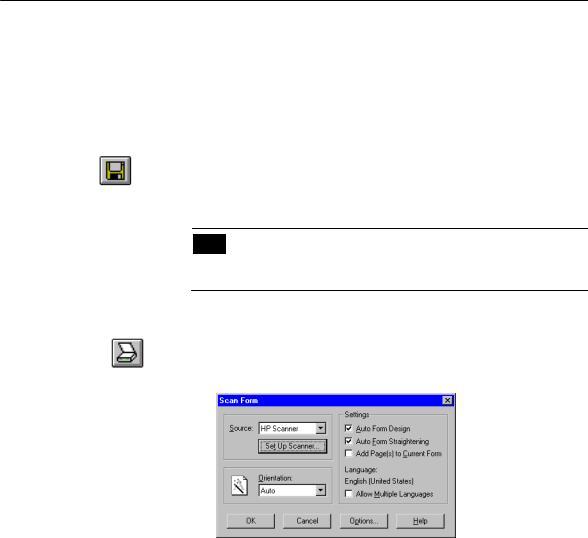
Tutorial 2 — Edit and Design a Form
Click Select Source... to select a TWAIN source. Click OK to return to the Scan Form dialog box. Proceed to step 3.
3Select Auto Form Design to use Logical Form Recognition to recognize text and fillable fields in the form.
4Click OK.
OmniForm scans the form, recognizes both text and fields, and opens it in design view.
5Click the Save button or choose Save in the File menu. The Save As dialog box appears.
6Type Sample2 in the File Name text box and click Save.
Proceed to the section “Verifying the OCR” on page 31 to begin using OmniForm’s design tools.
To import the form as an image file:
1Click the Scan Form button in the standard toolbar or choose Scan Form... in the File menu.
The Scan Form dialog box appears.
2Select Image File(s) in the Source drop-down list.
3Click Select Files... to open the Select Files dialog box.
•Select TIFF Files in the Files of Type drop-down list.
•Windows 95/NT users: locate the sample.tif file in the
OmniForm\Sample Forms folder.
•Windows 3.1 users: locate the sample.tif file in the omniform\samples directory.
Tutorials - 29

Tutorial 2 — Edit and Design a Form
•Double-click the file to place it in the Files to Process list box.
•Click OK to return to the Scan Form dialog box.
4Click OK in the Scan Form dialog box.
5OmniForm loads the form, recognizes both text and fields, and opens it in design view.
6Click the Save button or choose Save in the File menu. The Save As dialog box appears.
7Type Sample2 in the File Name text box and click OK.
The next section explains how to begin using OmniForm’s design tools.
Tutorials - 30
